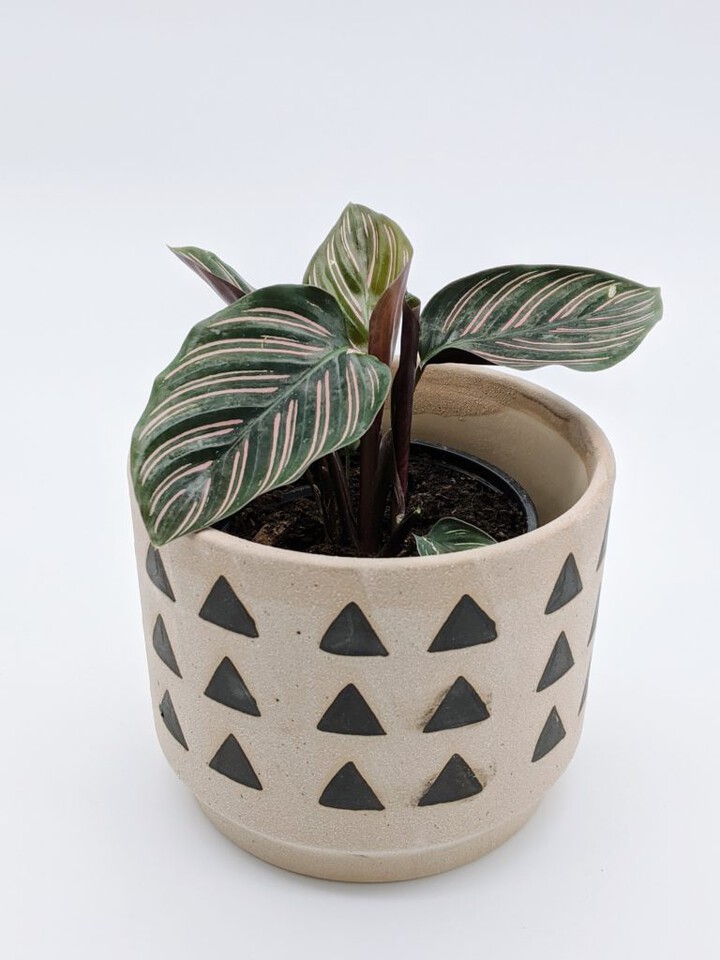Another member of the Marantaceae family (the “Prayer Plant” family), Calathea Ornata is unique due to the pale pink and delicate pinstripes running through its dark green oval leaves (hence its nickname of “Pinstripe Plant”). Much like other Calathea plants, Ornata can be a bit finicky, so we recommend this plant be taken in by Plant Parents who have some existing experience with tropical houseplants. Calathea Ornata is native to Africa, the West Indies, Thailand, Central America, and South America. As a result, and like its cousins, Ornata prefers and needs a humid place to live. If you live in a dry climate like the one we have here in Colorado, the bathroom is a great place for Calathea plants as long as it’s well-lit. If you don’t have good light in your bathroom (or if you already have too many ferns and calathea and other humidity-loving houseplants in there), place a humidifier near the plant, or put the entire pot (including the tray) on a dish of pebbles, and keep the dish filled with water. As the water evaporates out of the dish, it will rise as humidity to help quench the plant’s thirst. You can also give the leaves a good spritz often to help combat dryness. Your Calathea Ornata will help you out by letting you know that it’s not getting enough humidity by developing brown edges around the outside of the leaves. Just carefully trim these brown edges and add some more moisture for your thirsty plant.
Calathea Ornata likes bright, indirect sunlight. If left too long in sunlight that is too bright, Calathea Ornata’s leaves will lose their trademark colors and can develop brown burns or sunspots (though Calathea Ornata’s stripes will change from pink to white as the plant ages). The movement of the sun will cause your Calathea Ornata (and other Calatheas, as well) to open and close its leaves. They open in sunlight, and close in darkness. When your Calathea plant’s leaves are closed, you’ll be able to see the trademark dark purple undersides of the leaves.

Like many houseplants, Calathea needs to be watered when the top inch of soil is dry, but not allowed to dry out completely. While Calathea Ornata can handle over-watering, it can’t handle sitting in puddles of water, so make sure to pour out any remaining water left in the pot’s tray. Avoiding watering until the first inch of soil is dry will cut down on the amount of tiny gnats you have flying around your house, as they nest in wet soil surfaces. Plant Calathea Ornata in soil that retains moisture well but is also going to drain off excess water – consider bark or moss as additions to the soil to achieve this goal. Use a pot that has good drainage to avoid root rot. If your pot has no drainage, use a Moisture Meter to check the soil in the bottom of the pot. If the soil in the bottom is still showing as “Wet,” it’s not time to water yet. Also take care with how much water you use to avoid too much water pooling at the bottom.
Keep Calthea Ornata at a temperate between 65 and 85 degrees Fahrenheit, and keep it away from drafts and vents. Not only does this disrupt the preferably consistent atmosphere around the plant, but it can also add to drying out the air around it. Calathea Ornata is considered to be an air-cleaning plant, and is also pet-safe, so no need to worry about keeping it away from pets or children who might decide to snack on the plant as you consider the best place for it.